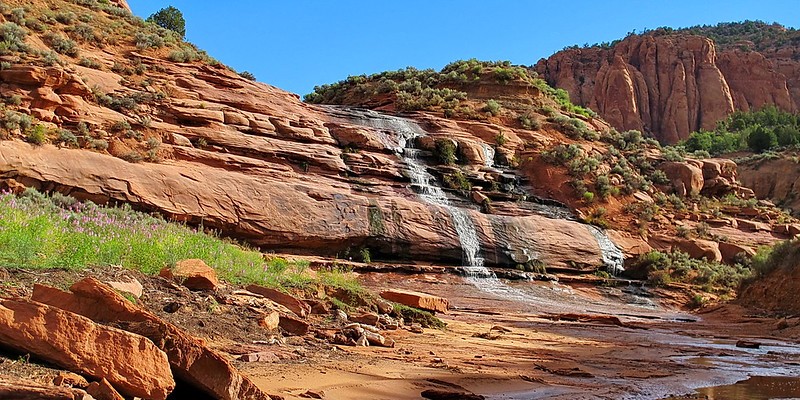By Jack Cahill.
For decades, people have flocked to Arizona for our abundant sunshine, resorts, and desert amenities. However, as Arizona has grown substantially, it is clear that our water is not abundant. Water scarcity is not a recent problem in Arizona, in fact, questions over who controls our limited and most precious resource have raged since before statehood.
These questions are of fundamental importance to the 22 federally recognized tribes within our borders; especially the Navajo Nation, the largest tribe by land and population. The Navajo water needs are serious in light of the persistent drought, and 30% of Navajo households still lack running water, as many residents travel vast distances to collect water from non-potable sources. Despite the nation’s serious water needs, no attempt has been made to quantify the water rights reserved to the nation from the Colorado River, though this may change this year when the Supreme Court rules on Department of the Interior v. Navajo Nation.
Historical Context
The Navajo Nation was established in 1868 and is an arid and sprawling nation that lies almost entirely within the Colorado River’s Drainage Basin, spanning across Arizona, New Mexico, and Utah.
The tribe’s fight to assert their right to water began in 1868, when the US and the Navajo Nation signed a treaty to fulfill the guarantees implicitly given to the Navajos when they formally entered the US, one of those guarantees being “sufficient water.” This theme carried into Winters v. US in 1908, where the Supreme Court sought to address questions of water supply for tribal nations and held that the US implicitly reserves “sufficient water rights” when they establish a reservation. Now known as the Winters Doctrine, the doctrine establishes that the minimum amount of water necessary to maintain a permanent tribal homeland constitutes such “sufficient water rights.”
The guidelines of this doctrine, however, have been unclear in light of other Supreme Court decisions. Notably, the Supreme Court issued a decree quantifying the Colorado River Water Rights of Lower Basin states, including Arizona, in the 1963 landmark Arizona v. California case. In doing so, however, the court only issued a decree outlining the rights of five of Arizona’s twenty-two tribes. Navajo Nation was not included. Although the US has modified the decree a number of times, it has never tried to quantify Navajo Nation’s right to Colorado River water.
How This Case Began
As a result of these inconsistencies, the Navajo Nation sued the Department of Interior in 2003, arguing that the federal government breached a fiduciary duty in failing to determine the quantity of water necessary to establish a permanent homeland and for failing to provide sufficient water to maintain the homeland. After several dismissals in the District Court and Ninth Circuit, Navajo Nation amended its original complaint and was finally met with a favorable ruling from the Ninth Circuit in 2021. The Ninth Circuit explained:
“Although there is no express law or treaty articulating an enforceable trust duty, the Winters Doctrine still implies a trust-obligation with respect to water allocation, which gives rise to implied water rights sufficient to support the reservation.”
The Ninth Circuit’s decision was monumental, as it recognized that the US has the power and duty to manage water as a trustee for the benefit of the Navajo Nation. The Ninth Circuit’s reasoning focused on the reality of the Navajo Nation, reiterating that it is an arid nation where water from the Colorado River is essential for sustaining farmland and the very fabric of the nation itself.
The Present Case
Both the Department of Interior and the State of Arizona appealed the Ninth Circuit’s decision, arguing that an implied trust obligation is unenforceable without any express obligation in law.
The Supreme Court granted certiorari and will hear oral arguments on March 20th, 2023. The outcome of this case has the potential to be monumental, as a victory for the Navajo Nation will affirm the legitimacy of tribal rights to water, regardless of whether or not such rights have expressly been stated or judicially adjudicated. Further, a victory for the Navajo Nation would allow tribes to secure their Winters Rights, regardless of whether such rights have been adjudicated.
It is difficult to predict the outcome of this case, but it will be fascinating to see whether or not Justice Gorsuch will continue his practice of siding with tribal nations, as evidenced by his dissent in Oklahoma v. Castro-Huerta or his historic ruling in McGirt v. Oklahoma, where he held that 40% of Oklahoma’s territory was tribal land.
Ultimately, Department of the Interior v. Navajo Nation will be a monumental case and, hopefully, we may finally see some deference to tribal sovereignty with respect to their water.


By Jack Cahill
J.D. Candidate, 2025
Jack Cahill is a 1L from Phoenix, AZ. Before attending law school, he studied Secondary Education at Northern Arizona University and taught 8th Grade English in Flagstaff. Outside of school, he enjoys hiking, skiing (although he’s not very good), and open-water swimming!
